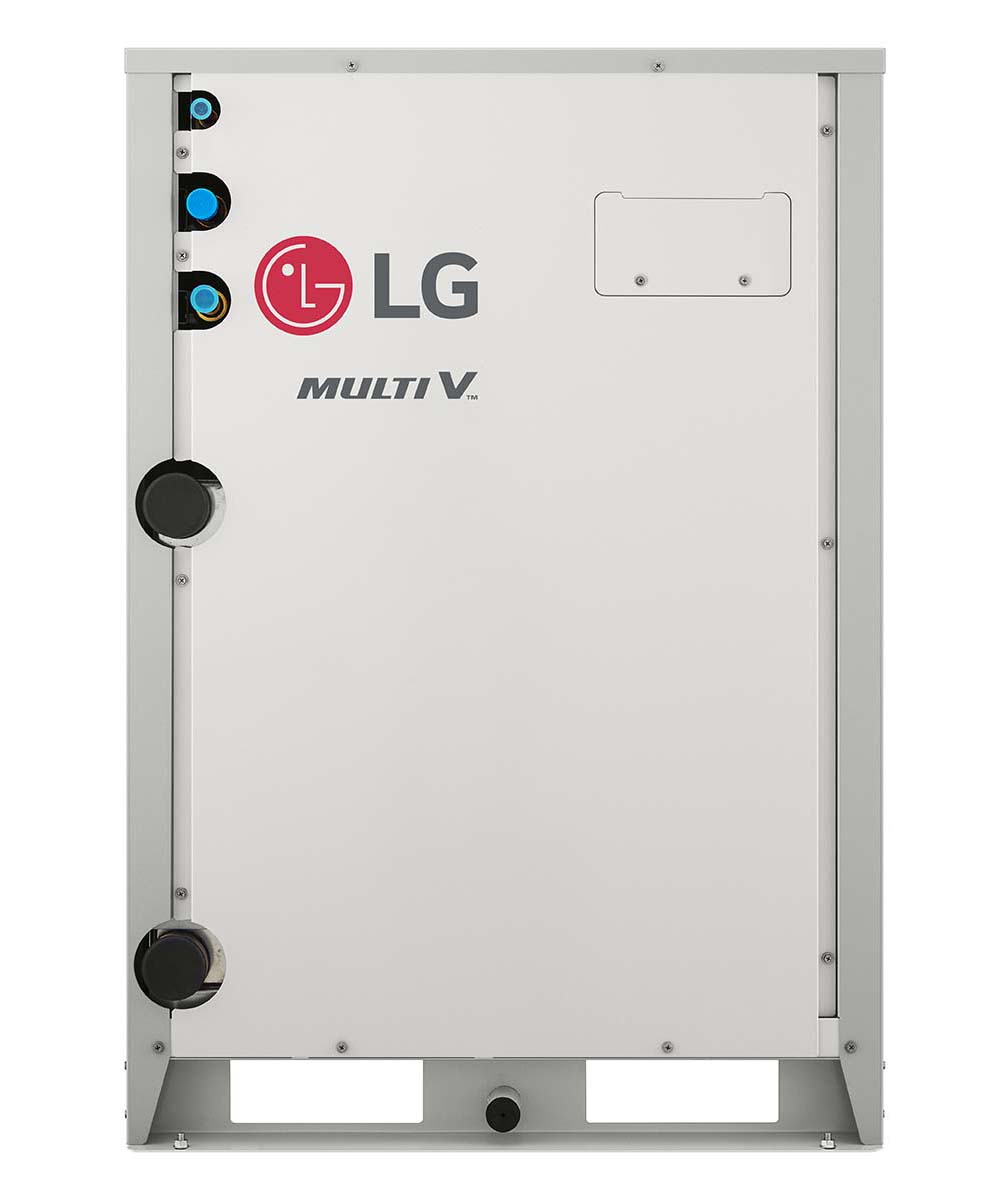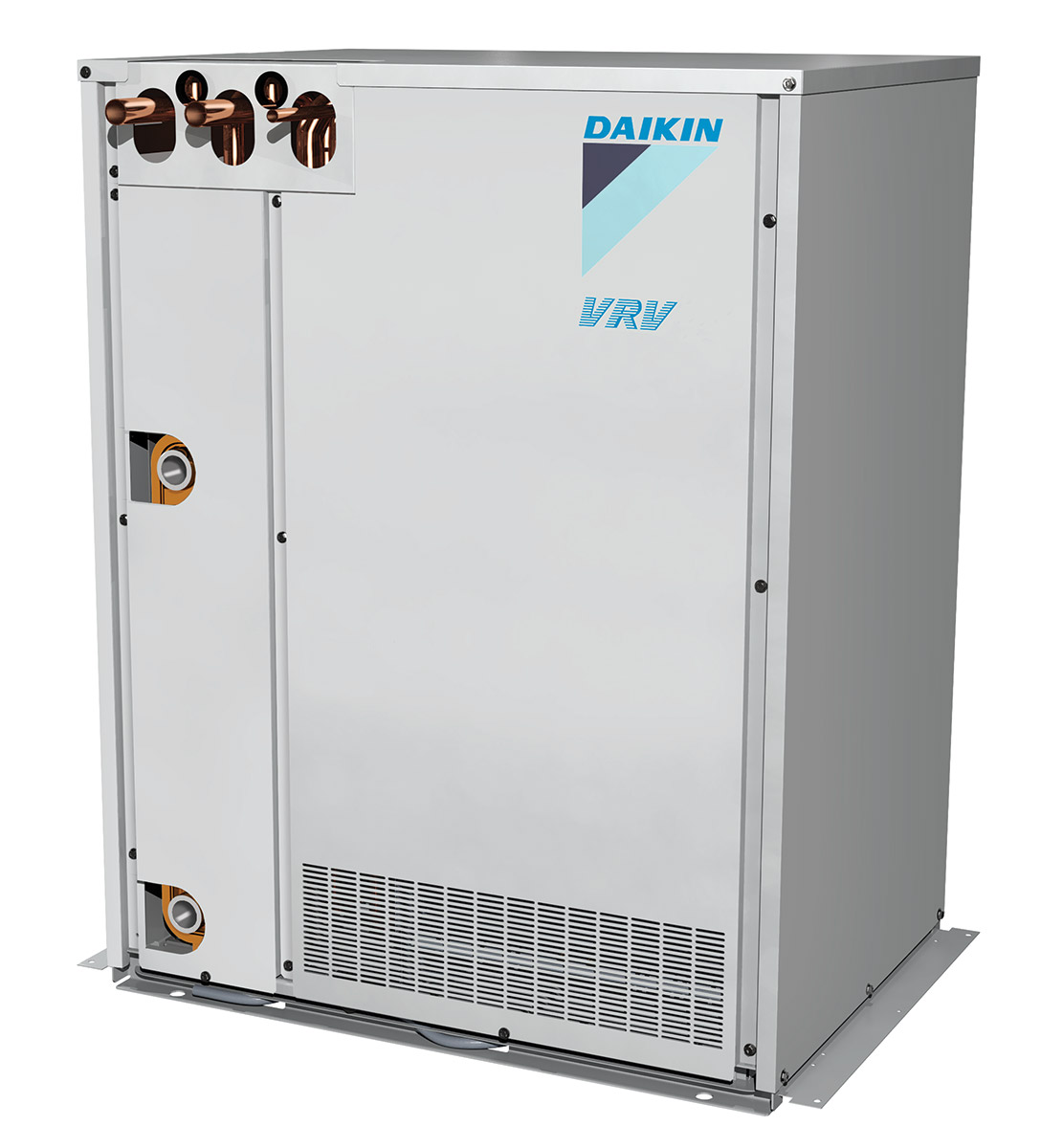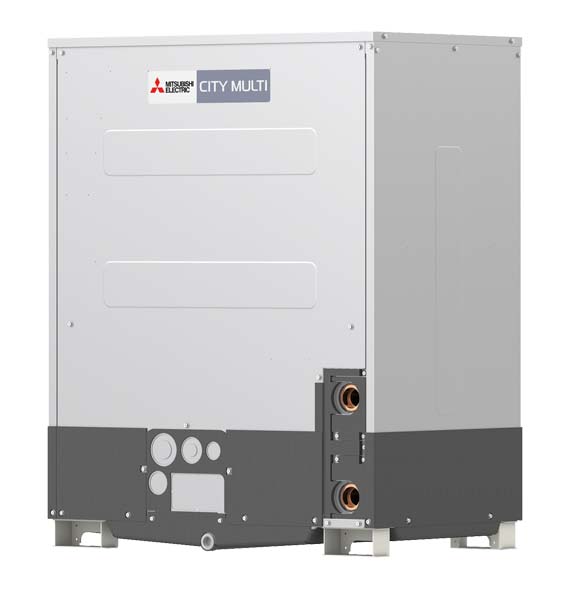Water-source variable refrigerant flow (VRF)/variable refrigerant volume (VRV) systems are compact, flexible systems designed to offer many of the same benefits of air-source VRF/VRV systems. These systems are suitable for projects where space is at a premium; in coastal regions where HVAC systems need to be placed indoors and protected from storms and harsh weather; or in cold climate applications, as they’re fed from geothermal or boiler/tower condenser loop configurations designed to reduce the derate associated with cold-climate VRF installations due to ambient temperature.
Several HVAC manufacturers offer these systems, each equipped with unique features and options designed to simplify installation and maintenance procedures.
General Benefits

MULTI V WATER 5: LG’s Multi V Water 5 water-cooled VRF system offers a wide line-up that ranges between 6 and 16 tons for single frame models. (Courtesy of LG Electronics Air Conditioning Technologies)
Water-cooled VRF systems are designed to save space. These units are often specified for large building and high rise applications, as both contain water-cooled modules that are located indoors, closer to the space they’re serving.
“Water-cooled VRF systems generally include less refrigerant piping and installation costs as well as lower overall refrigerant charge per system compared to air-cooled VRF systems,” said Matt Blocker, senior manager of commercial product development, Mitsubishi Electric Trane HVAC US (METUS).
“Because of its size, a machine room’s size can be reduced,” said Trey Wilder, senior product support engineer, LG Air Conditioning Technologies. “Multi V Water 5 allows for more flexible design of refrigerant piping as well, which also may help save space.”
Water-cooled VRF units allow for heat recovery between systems, too.
“One system pulls heat out of a space to the condenser loop and then shares the generated warmth to another system needing it,” said Blocker. “The result is double heat recovery. Further, water-cooled systems utilize a geothermal loop that, for example, in a cold climate, may only reach 30° to 40°F versus the outside ambient air that may reach minus 20° in some colder markets. Thus, the compressor has to do less work.”
LG’s Multi V Water 5 offers a heat pump or heat recovery configuration in one system.
The unit can remove heat from the inverter PCB through a refrigerant-cooling heat sink,” said Wilder. “This helps keeps the machine room temperature low without the need for additional ventilation or cooling.”
Water- and air-cooled VRF/VRV systems offer many additional benefits, including inverter compressor technology, compact modular design, long piping lengths, high part load efficiencies, low noise levels, and diverse selection of indoor unit types. In applications where the ambient conditions pose challenges for air-cooled VRV systems, water-cooled VRV solutions can become the ideal choice.
“The long piping capabilities, small refrigerant pipes, compact condensing unit size, and ability to take advantage of building diversity and two-stage heat recovery provide great flexibility in applying the solution to a building whether in existing or new construction,” said Madhav Kashinath, director, VRV products, Daikin Comfort Technologies North America Inc. “The application flexibility aids in reducing the overall construction complexity compared to traditional water-based systems and helps optimize the total cost of construction.”
Contractor Advantages
Engineered with application flexibility and ease of installation in mind, Daikin VRV T-Series water-cooled units offer several benefits to HVAC contractors.

VRV T-SERIES: Engineered with application flexibility and ease of installation in mind, Daikin VRV T-Series water-cooled units offer several benefits to HVAC contractors. (Courtesy of Daikin)
“The segmented front panel design of Daikin’s VRV T-Series Water-Cooled units separates the water section from the electrical section, which simplifies the panels and components that contractors need to handle during installation and maintenance of the product,” said Kashinath. “The drop-down electrical box, which can be accessed by removing just two screws, provides easy access to the critical components during regular operation and maintenance. The ability to easily convert from front piping to top piping offers flexibility to customize piping design on-site.”
METUS water-cooled units are internally chilled, meaning no heat is dissipated to the space where they are placed. This ensures that contractors do not have to account for cooling or ventilation for the heat rejected into the mechanical room.
“METUS units also feature an electronic pressure independent valve [EPIV] that allows for easy modulating flow on the condenser water loops and eliminates the requirement to balance the water-flow rate to each module,” said Blocker. “Further, since modules are internally cooled, we have smaller service requirements on the sides and back of each module. This enables them to fit into smaller spaces without impacting the equipment. In fact, everything is serviceable from the unit’s front.
LG’s Multi V Water 5 water-cooled VRF system offers a wide line-up that ranges between 6 and 16 tons for single frame models. The unit enables up to three-unit combination models that extend the line-up up to 48 tons.
“LG Multi V Water 5 combines the advantages of chiller and air-cooled VRF systems while avoiding the shortcomings of air-cooled VRF and chiller systems,” said Wilder. “LG can support Multi V Water 5 pipe sizing with software, which is beneficial essential for contractors.”
Applications
Daikin’s VRV T-Series Water-Cooled is a flexible and modular energy-saving alternative to traditional centralized equipment solutions, such as chilled water system or water-source heat pumps (WSHPs).
Twenty-eight VRV water-cooled units were recently installed at the Duke Ellington School of the Arts, a 265,000-square-foot, LEED GOLD high school in Washington, D.C., delivering a total of 466 tons of capacity.
The water-cooled condensing units utilize a refrigerant loop that transfers energy from the indoor fan coils to the condensers in cooling mode. Then, a water loop absorbs the rejected energy and releases it via a cooling tower. Inverter compressors deliver precise amounts of refrigerant to each indoor fan coil, reducing energy consumption by variably providing only the energy required to heat or cool the space.
“Thanks to heat rejection cancellation technology, the water-cooled VRV system minimizes heat addition to a mechanical room, reducing the additional mechanical room conditioning loads,” said Kashinath. “With a wide range of inlet water temperatures as low as 14° in heating and up to 113° in cooling, the Daikin VRV T-Series is an ideal choice for many water-cooled/water-source commercial applications.”
The school has won several awards since re-opening in 2017, including the Engineering News-Record award for “Best K-12 Education Project” for the Mid Atlantic region and the 2018 “First Award,” an international architecture design award for nonresidential buildings.
“The consulting engineer and the mechanical contractor worked diligently to optimize this building’s total life-cycle costs by leveraging Daikin’s water-cooled VRV capability and functionality as well as reducing the maintenance and increasing efficiency that the school will see for many years to come,” said Tim Dorman, sales engineer, Havtech, which served as the project’s manufacturer rep.

MODULAR HEAT PUMP: The METUS PQHY modular heat pump system combines the convenience of water source with VRF technology. (Courtesy of METUS)
Mitsubishi Electric Trane HVAC US has single modules from 6-20 tons in both Heat Recovery PQRY and Heat Pump PQHY. These can be combined for a maximum system size of 28 tons of cooling, equivalent to 336,000 Btu/h. The compact units can be stacked on a field-supplied rack to maximize vertical space.
In 2021, the Credit Human Headquarters in San Antonio tapped METUS’s water-source VRF systems to maximize the efficiency and sustainability of its 12-story, 200,000-square-foot office facility.
Steve Hennigan, CEO of Credit Human, worked with the METUS team to design a water-source VRF heat recovery system with approximately 900 tons of capacity, supported by 152 ground-linked wells, to condition the company’s new headquarters.
“It’s basic physical and environmental stewardship,” said Hennigan, describing his decision to go with METUS’s ground-linked water-source VRF system. “One of the things most people don’t understand about this area of the country is that water is a big deal. Cooling towers use lots of water, so by going with a ground-source system, we went from the design possibility of having six cooling towers to only two. That decision alone reduced our water consumption by more than 1 million gallons of potable water per year.”
Ground-linked systems supply a relatively constant water temperature, allowing the mechanical system to operate with optimized efficiency. These systems are especially advantageous in locales like San Antonio, where average outdoor air temperatures fluctuate by almost 90° between summer and winter months. While winters tend to be mild, the region’s hot and humid summers force air-source mechanical systems to work harder to reach a building’s indoor temperature set point. By comparison, ground-water temperatures fluctuate by a much narrower range of 10°-20°. Ultimately, water-source systems used in these climates are generally able to deliver efficiencies three or four times higher than air-source VRF systems.
“The HVAC system serving the Credit Human building achieves a high level of energy efficiency and sustainability,” said Steve Straus, president of Glumac. “The ground-source geothermal system consisting of 300-foot-deep wells supports the Mitsubishi Electric water-source VRF system. In the winter, the system is able to utilize the abundant heat in the ground that’s been stored through the summer months. In the summer, heat is reclaimed from air conditioning for domestic hot water.
“The water-source VRF system is probably the most efficient system you can design for this building,” said Henry Delgado, mechanical engineer for the southwest business unit, METUS, who played an integral role in the system’s design. “It takes advantage of multiple levels of heat recovery and allows you to design your system independently of ambient outside air conditions. The building itself is 56 percent more efficient than a typical building utilizing the code minimum equipment. It’s estimated to save 1.45 million kilowatts of electricity per year because of its highly efficient design and systems.”



Report Abusive Comment